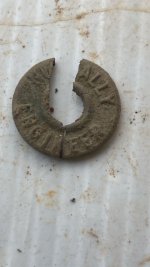Spanish galleon wreckage found?
STEVE LYTTLE
Divers found an object underwater Wednesday that might be the wreckage of a 500-year-old Spanish ship, South Carolina officials say.
The ship was a lead vessel in an expedition headed by the first European explorer of South Carolina -- and the first European possibly to have landed along the North Carolina coast.
Underwater archaeologists found an object, perhaps 100 feet long, buried under sand in water near South Island, off Georgetown County.
The discovery was announced by Jim Spirek, of the S.C. Institute of Archaeology and Anthropology. It was reported in today's editions of the Myrtle Beach Sun-News.
According to the Sun-News, the object was discovered about noon Wednesday. Divers plan to return to the site in September, to look for additional items.
Spirek told the Sun-News that the object could be part of the wreckage from the Chorruca, a Spanish galleon that sank in 1526 in Winyah Bay. The Chorruca was a lead vessel in the expedition headed by Lucas Vazquez de Ayllon, a conquistador born in 1475 in Toledo, Spain.
De Ayllon had settled on the island of Hispaniola (the island where today's Dominican Republic and Haiti are located) and was a successful business owner there. In 1523, he was asked by King Charles I of Spain to look for a route from the Atlantic Ocean through the newly discovered American continent to the Pacific Ocean.
De Ayllon tried to find such a passage along the Carolinas coast and is thought to have landed in the Cape Fear area. He also is credited as being the first European to discover Chesapeake Bay.
In 1526, he headed an expedition of 600 colonists hoping to begin life on the South Carolina coast.
During that expedition, the Chorruca sank. The colony did not last long. There was a fight over leadership, during which African slaves reportedly escaped and joined nearby Native American tribes.
A fever epidemic broke out, killing de Ayllon and many others.
About 150 survivors gave up the effort in late 1526 and returned to Hispaniola.
Divers from the South Carolina agency are involved in a major effort along the coast to locate the wreckage of old ships.
STEVE LYTTLE
Divers found an object underwater Wednesday that might be the wreckage of a 500-year-old Spanish ship, South Carolina officials say.
The ship was a lead vessel in an expedition headed by the first European explorer of South Carolina -- and the first European possibly to have landed along the North Carolina coast.
Underwater archaeologists found an object, perhaps 100 feet long, buried under sand in water near South Island, off Georgetown County.
The discovery was announced by Jim Spirek, of the S.C. Institute of Archaeology and Anthropology. It was reported in today's editions of the Myrtle Beach Sun-News.
According to the Sun-News, the object was discovered about noon Wednesday. Divers plan to return to the site in September, to look for additional items.
Spirek told the Sun-News that the object could be part of the wreckage from the Chorruca, a Spanish galleon that sank in 1526 in Winyah Bay. The Chorruca was a lead vessel in the expedition headed by Lucas Vazquez de Ayllon, a conquistador born in 1475 in Toledo, Spain.
De Ayllon had settled on the island of Hispaniola (the island where today's Dominican Republic and Haiti are located) and was a successful business owner there. In 1523, he was asked by King Charles I of Spain to look for a route from the Atlantic Ocean through the newly discovered American continent to the Pacific Ocean.
De Ayllon tried to find such a passage along the Carolinas coast and is thought to have landed in the Cape Fear area. He also is credited as being the first European to discover Chesapeake Bay.
In 1526, he headed an expedition of 600 colonists hoping to begin life on the South Carolina coast.
During that expedition, the Chorruca sank. The colony did not last long. There was a fight over leadership, during which African slaves reportedly escaped and joined nearby Native American tribes.
A fever epidemic broke out, killing de Ayllon and many others.
About 150 survivors gave up the effort in late 1526 and returned to Hispaniola.
Divers from the South Carolina agency are involved in a major effort along the coast to locate the wreckage of old ships.






